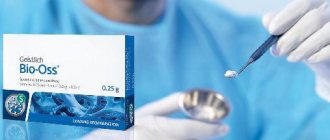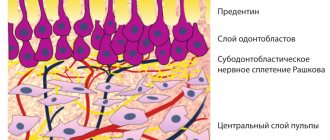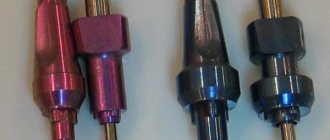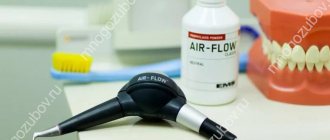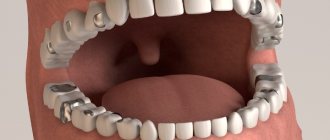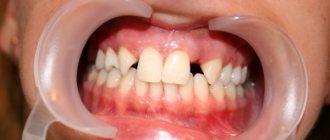865
The use of compomer materials in dental practice makes it possible to eliminate dental defects not only in adult patients, but also in children.
At the same time, a high level of aesthetic indicator is noted. The manufactured fillings are also distinguished by the feature of not losing their natural color for a long time.
Overview characteristics
Compomers get their name from the combination of restorative materials such as composites and glass ionomers.
This type of material is polymerized through double curing. Initially, methacrylate resins are activated under the influence of ultraviolet rays. Subsequently, under the influence of oral fluid, glass ionomer components are bound directly inside the filling.
It is important to know! During the second stage of curing, the installed filling can increase in volume by up to 3%. This compensates for the process of possible shrinkage of the material.
Initially, it was assumed that the combination of composite materials and glass ionomer cements would absorb the best positive qualities of these compounds. But, as practice has shown, these expectations were not met. Therefore, to ensure high strength, glaciosites are used in tandem with adhesives.
Properties of compomers
Compomers combine the positive properties of glass ionomers and aluminosilicate glass. In fact, it is a combination in the form of photopolymerizable composites and glass ionomer polymers, characterized by color fastness, high aesthetics and ease of application. Biological compatibility is good, as is adhesion to dentin tissue. The composition includes fluorine, which has protective and preventive functions.
Properties:
- single-component composition;
- chemical adhesion;
- the total shrinkage of the mass is small;
- high aesthetics;
- cumulative effect due to fluoride content;
- biological compatibility;
- solubility in natural oral fluids is low;
- the surface is polished after installation;
- the level of expansion is close to that of tooth tissue;
- Curing requires two steps - exposure to light and absorption of natural oral fluids.
Classification and main components
The chemical composition of compomer materials includes:
- two types of acid (composite and polyacrylic);
- strontium fluorosilicon glass;
- strontium fluoride compounds;
- stabilizers giving the necessary consistency;
- substances that initiate the polymerization process.
Depending on the area of application of these restoration materials, they are either packable or fluid.
Packable
Allowed for use when the elimination of carious cavities does not occur on the frontal incisors of the front row due to the low level of aesthetic value.
The material is mainly used when installing fillings on molars or premolars, but only in that part of the tooth that experiences minimal pressure during the chewing process.
All materials in this group are characterized by high density and are highly filled. According to clinical studies, compomers do not differ in their characteristics from hybrid composites, and in some situations they are even inferior in strength.
The advantages of this type of material include:
- ease of use;
- high strength;
- radiopacity.
The disadvantages are the short working time (up to 1 minute) due to the rapid setting. Also, in some cases, problems arise with edge adaptation.
Liquid-flowing
Materials of this group are divided into high-, medium- and low-flow. Most often they are used as filling agents to eliminate carious cavities of classes III, V, when it becomes difficult to use conventional composites (narrow and hard-to-reach cavities, chips).
They can also be used to fix fixed dentures. In some cases, the combination of compomers with other materials allows them to be used as a base layer, which provides a good marginal seal.
Most practitioners note the following positive qualities of these materials:
- high degree of aesthetics;
- good for polishing.
The main disadvantage is high shrinkage and low strength.
Types of cements
Dental cements and other filling compounds are used in the treatment of permanent and primary teeth in the form of fillings, linings, obturation materials and sealants.
They are classified according to their basis, and can be of the following types:
- Mineral cements. They are made on the basis of phosphoric acid, which is why they are called “phosphates”. These include zinc phosphate, silicate and silicophosphate compounds.
- Polymer cements. They use organic acid as a base, usually polyacrylic acid. This group includes polycarboxylate and glass ionomer cements.
- Oil-based formulations. The main material of this group is zinc oxide-eugenol cement.
- Water-based materials (water-based dentin).
Phosphates
Phosphates in pediatric dentistry are used as a permanent filling material or to form insulating linings.
The powder consists of 70-90% zinc oxide. It requires liquid to mix it.
The mixture hardens in 3-9 minutes at room temperature, but this time can be increased if you use a cooled plate when kneading.
The substance has the following advantages:
- fast hardening;
- good strength characteristics;
- plastic;
- low level of shrinkage.
However, such a substance has low aesthetic appeal, wears off quickly and can break, and irritates the pulp. The product does not provide an antibacterial effect, although many manufacturers have begun to add silver to the composition.
Phenolates
Zinc oxide eugenol cement is produced in the form of a white powder containing oxides of magnesium and zinc.
To mix the solution, a liquid containing eugenol with cottonseed oil (or olive) is required. Depending on the type of material, it takes 5 minutes or about 24 hours to harden.
The advantages are:
- acceptable level of acidity (pH 6.6-8.0);
- no impact on the pulp;
- antiseptic and bactericidal properties;
- slight anesthetic effect;
- good ductility and ease of use;
- radiopacity.
Disadvantages include solubility under the influence of saliva, insufficient mechanical strength, and the ability to disrupt the polymerization of composites, therefore it is not used as a base.
Polycarboxylates
Polycarboxylate cement is a powder containing calcium salts, magnesium and zinc oxide. It also sometimes contains colored pigments.
The substance is used for filling both temporary and permanent teeth. The main characteristic is good adhesion to enamel and dentin.
At room temperature, the mixture hardens in 2-3 minutes, at 37 degrees this time increases to 6-9 minutes.
The product has the following advantages:
- high adhesion to dentin and tooth enamel;
- practically does not irritate the pulp;
- complete biological compatibility with tissues;
- antibacterial effect;
- radiopacity.
However, this product has disadvantages. It is not durable enough, there are difficulties in use due to the short working time. Aesthetic unattractiveness and the presence of shrinkage are also noted.
There is also difficulty in removing excess cement. If the procedure is carried out too late, the composition will be difficult to separate from the enamel. Cleaning too early will damage the edge seal.
Acrylates
Such cement compositions are two-component. They are presented in the form of liquid and powder, two pastes. The powder contains quartz or borosilicate glass.
The mass hardens in 6-7 minutes, and the total working time is 10-11 minutes. This cement is characterized by high strength and resistance to the oral environment.
However, it is difficult to work with; the material irritates the pulp. Excess is difficult to remove.
Composites
The most common materials for filling teeth are light-curing composites. They freeze under the influence of light of the appropriate frequency. In appearance they are most compatible with the shade and structure of tooth enamel. They are distinguished by excellent strength, can be polished well and are almost invisible on the teeth. Due to their high height, these fillings are ideal for installation on the front teeth.
Plastic materials
Chemically cured plastics are used as filling materials. Such fillings harden fairly quickly, do not cause irritation to the oral cavity, and are resistant to chemical reagents.
Carbondent, acrylic oxide or polymethylsiloxane are used for manufacturing. The materials are resistant to abrasion, but due to subsidence, chemical toxicity and changes in the original shade in dentistry, plastic is used mainly for installing temporary fillings.
Metal fillings
To create metal fillings, alloys based on copper, silver, mercury and other metals are used. Since such materials do not serve an aesthetic function, dentists usually use them when filling molars. They are highly wear-resistant and affordable.
Almagams
Inexpensive and durable, almagam material consists of zinc, tin, silver and mercury, which gives it a dark color. Most often, almagama is used as a filling to treat chewing teeth. Advantages include durability, ductility, ease of installation and low cost. Disadvantages - unsightly appearance, long hardening, release of mercury vapor, increased thermal conductivity and shrinkage of the material.
Gold alloy
Fillings made from precious metals or their analogues are not particularly popular in dentistry. Most patients today prefer naturalness and authenticity. If the patient chooses a gold alloy as a filling material, then you should pay attention to some features: durability, excellent strength, but rather high cost.
Compomers
Good restoration materials for making fillings are compomers - composite-ionomer compositions. Compomers perfectly combine the best qualities of glass ionomers and composites, which provides the material with excellent chemical adhesion, biocompatibility, ease of installation, preservation of the original color and aesthetics.
This is interesting: Why do teeth react to cold?
Due to the low release of fluoride and insufficient strength, filling teeth with compomers is advisable in cases where it is necessary to achieve maximum aesthetics.
Application
Based on their characteristics, compomers can be used in the following cases:
- to eliminate carious cavities, cracks and chips in temporary and permanent teeth (classes I to V according to Black);
- if it is necessary to fill defects after preparation;
- with erosive processes on the surface enamel of teeth;
- if the cutting edge is not affected, it can be used to eliminate defects in teeth located in the smile zone;
- use as an insulating gasket or sealant.
Properties of the drug Forphenan and its purpose in dentistry.
Come here to take a closer look at Herculite filling material.
At this address https://zubovv.ru/lechenie/zubyi/plombyi/ionozita-v-stomatologicheskoy-praktike.html we will talk about the purpose of the dental material Ionozit.
Scope of application and indications for use
Compomers are widely used in dentistry for the following purposes:
- filling carious cavities in temporary teeth (class lV according to Black), if it is possible to isolate the tooth cavity from oral fluid;
- used after mandatory preparation - filling defects located in the neck of the tooth;
- with enamel erosion or wedge-shaped defects in permanent teeth;
- for traumatic damage to teeth (used as a temporary filling);
- filling the defect if it is on the approximal surface of the incisors, without affecting the cutting edge;
- as an insulating gasket;
- as a sealant.
Types of compomers:
- Packable . Universal materials for fillings and restoration are used instead of composites in cases where high demands are not placed on the aesthetic appearance of the filling and it will not be located in the part of the tooth that is most susceptible to chewing pressure.
- Liquid-flowing (flow-) are used for filling narrow defects that are difficult to access with conventional, condensable materials, as a sealant for fissures, or for fixing orthopedic fixed structures.
Positive and negative points
The main advantages of compomer materials are the following qualities:
- Duration of action. Over the course of 300 days, there is a constant release of fluoride ions, which helps strengthen tooth tissue.
- They have a high degree of biocompatibility and adhesion.
- Accumulation effect. When the supply of fluoride ions in the filling runs out, its adsorption from toothpastes or elixirs begins.
- There is no need for total etching. The use of adhesive systems is sufficient.
- Ease of operation compared to composite materials.
- When filling incisors, better aesthetic results can be achieved compared to glass ionomer cements. Also, unlike them, it has increased strength, ductility and durability.
- No stress is caused in the filling due to two-phase curing.
The disadvantages of using this type of restoration material include:
- may fade and change color over time;
- poorly ensure the marginal seal of the filling;
- compared to composites, they are less aesthetically pleasing;
- wears out faster than established hybrid composites;
- do not have the properties to bind to tooth dentin.
Experts' opinions
Today, experts advise using high-quality composite materials for the treatment of permanent teeth in children. Photopolymers are used if the patient sits quietly in the doctor’s chair and gives him the opportunity to thoroughly clean the aching tooth.
You should not place such fillings if the carious process is advanced and hygienic care is insufficient. In this case, the photopolymer will be fixed to the weak enamel.
When installed correctly, the composite will last a long time. The product ensures the aesthetics of the tooth and has excellent adhesion. Minimal preparation is required to apply the composite.
If primary molars are subject to repair, then cement filling materials are suitable . They are not strong enough to be placed on chewing teeth. They are best used for temporary fillings.
The most popular types
Despite the wide variety of restorative materials of this type, dentists choose compomers from certain manufacturers. They differ in their characteristics and can be used in different cases.
Dyract eXtra
This filling composition is used to eliminate defects that occur in incisors and molars.
The main advantage of this material is the constant release of fluoride ions, which helps prevent caries, preventing its re-development after filling.
The main indications for use are cases when there is a need for restoration of carious cavities in children and adult patients.
Contraindications include:
- situations when one of the ingredients becomes an allergen for the patient;
- if during the manipulation it is not possible to eliminate the effect of salivary fluid or blood;
- when, after the formation of the stump, the use of a ceramic crown is assumed.
Important! The color selection occurs after the surface enamel is moistened. The composition of Dyract eXtra has 6 tones, which allows you to choose the desired shade.
Glasiosite
The restoration composition is available in capsules with a volume of 0.25 g. It is used in the following cases:
- to eliminate carious cavities in baby teeth;
- when performing veneering work on teeth located in the smile zone;
- for long-term restoration of class I and II;
- if extended sealing of fissures (natural pits and depressions on the chewing surface of teeth) is necessary.
When using Glasiosite material, the following advantages are noted:
- high level of strength ensures resistance to abrasion;
- there is a good connection with surface enamel and dentin;
- stable and long-term fluoride production;
- good color rendition, which is why the filling is almost invisible in the smile area.
Twinky Star
German manufacturers have taken an original approach to solving dental problems that arise in childhood.
The bright and different colors of the filling composition can reduce the child’s feeling of fear when visiting the dentist.
The compomer curing process occurs in two stages:
- under the influence of a halogen lamp during the filling installation procedure;
- within two months, under the influence of moisture, the hardness coefficient increases.
When using this composition, high quality of the final result is ensured. In addition, it has a high degree of biocompatibility and prevents the development of caries.
Twinky Star does not apply:
- if allergic reactions occur to its components;
- in case of need of direct covering of dental pulp;
- when it is not possible to completely isolate the tooth;
- in combination with cements containing zinc oxide;
- if a heart rate pacemaker is installed.
Comp Natur
The presence of a pink tint in the Comp Natural material allows restoration work to be carried out in areas with damage to the neck of the tooth (especially on the incisors). According to Black's classification, the composition is used in the treatment of class V cavities.
This type of cement composition is characterized by high strength, good color transfer and low abrasion. For convenience, Comp Natur is available in capsules.
MagieFil
This type of cement composition is used to treat temporary teeth. Like all representatives of these materials, it has double curing.
Simultaneously with the therapeutic effect, it has a preventive effect, preventing the occurrence of carious cavities. Available in 4 variations of different shades.
Ionosit Seal
A type of light-curing radiopaque material that is used to fill fissures (most often on baby teeth).
It contains fluorine and zinc ions, which prevents the development of caries. When used, no adverse reactions are observed, except in cases where one of the components causes symptoms of an allergic process.
Ionosit-Baseliner
Glaciosite is used as an insulating gasket. When used, practitioners note the following advantages of the material:
- has a natural tooth color;
- well adapted to narrow fissures;
- fills even minor depressions and pits;
- releasing zinc and fluoride ions, prevents relapse of caries;
- The convenient applicator ensures comfortable work.
In rare cases, due to hypersensitivity to the main or additional components, allergic reactions may occur.
Composition and properties of the drug Kalasept and instructions for use in dentistry for dental treatment.
This post is all about using Proroot Mta Dentsply.
Here https://zubovv.ru/lechenie/zubyi/plombyi/irrigatsii-kornevyih-kanalov.html we will consider the requirements for solutions for root canal irrigation.
Advantages and disadvantages
Advantages:
- fluoride release continues for about 300 days;
- The material is elastic, easy to use;
- shrinkage is low, and the material does not crack;
- special disinfection before filling is not required, nor is the use of additional etching components.
The material is universal, used for treatment and restoration due to its properties. But, despite the multiple advantages, compomers have a number of disadvantages:
- color changes over time due to absorption of oral fluids;
- aesthetics are lower than that of composite materials;
- marginal fit is insufficient;
- bending strength and elasticity are lower than those of analogues based on pure composites;
- only mechanical retention, that is, there is no chemical connection with dentin tissues.
Indications for use
Indications:
- restoration, filling cavities due to caries;
- restoration of temporary (baby) teeth;
- treatment of enamel erosion;
- elimination of wedge-shaped defects;
- treatment of class 5 cavities;
- filling small cavities of classes 1-2 for permanent teeth;
- restoration for traumatic lesions;
- fixation of orthopedic and orthodontic structures;
- treatment of dentin under crowns;
- use in the form of gaskets with protective properties.
Contraindications
The use of materials has a number of contraindications:
- allergic reactions to components of dental glue, actylate and methacrylate plastics included in compomers;
- cavities of class 1, 2, the dimensions of which exceed two-thirds of the distance between the tubercles;
- restoration of the stump of the unit is required.
Manufacturers
Compomer filling materials are available from many brands, including Dentsply, Voco, Vivadent, DMG, 3M, Espe and Kerr.
Dentsply offers restorative universal materials from the manufacturer Dyract Extra 3rd generation. They are used for filling cavities of various types for units at any position in the row. The filling material contains fluoride; the materials have a cariesstatic effect. The product has a creamy consistency, which allows you to quickly apply the material, filling cavities. The advantages include abrasion resistance, properties comparable to composites, and a good range of shades.
VOCO offers Glasiosite materials - a condensable, easy-to-use, universal material with radiopaque properties, used to fill cavities of four classes - 1-3, 5. The product is suitable for restoration, including aesthetic, sealing of existing fissures, treatment of the frontal part of the row. The advantages of Glasiosite materials include:
- conducting fluoride therapy;
- stability, transparency of the shade;
- surface polishability after polymerization;
- abrasion resistance;
- strong bond with dentin tissues, thanks to self-etching special glue.
Twinkie Star is a material used to restore time series units. The eight-color compound with a slight glitter effect contains fluorine and is durable and abrasion-resistant. Thanks to its interesting glitter effect, the composition has an excellent motivating effect for the treatment of caries and other problems in children.
The cost of using the product depends on the chosen option, for example, a set of 40 compules produced by Dyract Extra costs approximately 8.5 thousand rubles. A set from Twinkie Star for treating children with colored sparkles - about 7 thousand rubles for a similar volume. Installation for one cavity also depends on the material and complexity of treatment; on average, the cost is 1-2.5 thousand rubles, excluding other measures aimed at eliminating the problem.
Features of use
When performing restoration work using compomers, the process of installing a filling is practically no different from using conventional composite materials.
Therefore, the following algorithm of actions is observed:
- Initially, professional cleaning of the sector in which the damaged tooth is located is carried out.
- To prevent relapse of caries development, preventive preparation is performed. This occurs with minimal cavity formation, as a larger area will increase the volume of the filling, which will reduce its strength.
- When dentin is deeply damaged, it becomes necessary to spot cover this area. For this purpose, calcium-containing pads are used. They are subsequently insulated with a glass ionomer cement composition.
- The adhesive system is applied.
- Layer-by-layer application of compomers is carried out by analogy with the use of composite compositions. The thickness of a single applied layer should not exceed 2.5 millimeters.
- Polishing and grinding of the tooth surface occurs at the end of the process.
You should know! Curing time for one layer is approximately 40 seconds. The use of an ultraviolet lamp should be directed to the location where the defect is being eliminated.
Principles of caring for fillings
In order for the filling to serve for a long time and efficiently, it is necessary:
- Regularly treat all areas of caries;
- Carefully observe oral hygiene;
- Review your diet, exclude those that destroy enamel - sweets, lemonades, carbonated drinks, unnatural juices, ketchups and sauces;
- Avoid temperature changes while eating;
- The lack of calcium in the body must be replenished with cottage cheese, natural dairy products and calcium carbonate tablets.
Price
Compomer compositions, despite some negative aspects, are widely used in dentistry. This is due to the fact that they have high strength, low shrinkage, and, importantly, prevent the re-development of carious cavities. In addition, they can be used for the restoration of frontal teeth.
The pricing of compomer cements is influenced by their release form and the brand name of the company.
So the cost of restoration material from the manufacturer Ionosit-Baseliner (DMG) will range from 600 to 800 rubles.
The average price for a Twinky Star set is approximately 5500-7000 rubles. For most types of material, the cost will be within 7,000 rubles.
The video provides additional information on the topic of the article.
Reviews, opinions, comments
Most dental practitioners note that the use of compomer cements will be effective when they are combined with the use of adhesive systems.
You can share your opinions and write a review in the comments to this article.
If you find an error, please select a piece of text and press Ctrl+Enter.
Tags: toothache, fillings
Did you like the article? stay tuned
No comments yet




